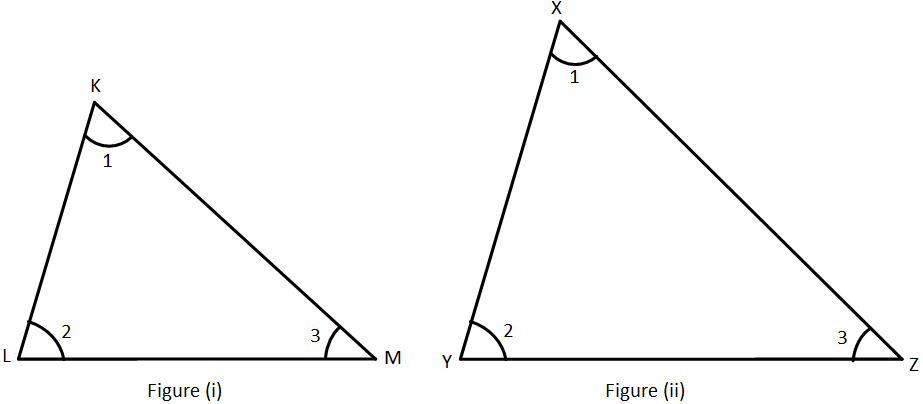Subscribe to our ▶️ YouTube channel 🔴 for the latest videos, updates, and tips.
Criteria for Congruency
Here we will learn different criteria for congruency of triangles.
I. SAS (Side-Angle-Side) Criterion:
If two triangles have two sides of one equal to two sides of the other, each to each, and the angles included by those sides are equal then the triangles are congruent.
Here in ∆KLM and ∆XYZ,
KL = XY, LM = YZ and ∠L = ∠Y
Therefore, ∆KLM ≅ ∆XYZ.
Note: It is necessary for the included angles to be equal for congruency. If in the above figure, ∠L ≠ ∠Y and ∠L = ∠X, the triangle may not be congruent.
II. AAS (Angle-Angle-Side) Criterion:
If two triangles have two angles of one equal to two angles of the other, each to each, and any side of the one equal to the corresponding side of the other, then the triangles are congruent.
Here in ∆KLM and ∆XYZ,
∠L = ∠Y, ∠M = ∠Z and KM = XZ.
Therefore, ∆KLM ≅ ∆XYZ.
III. SSS (Side-Side-Side) Criterion:
If two triangles have three sides of one equal to three sides of the other, the triangles are congruent.
Here in ∆KLM and ∆XYZ,
KL = XY, LM = YZ and KM = XZ.
Therefore, ∆KLM ≅ ∆XYZ.
IV: RHS (Right Angle-Hypotenuse-Side) Criterion:
If two right-angled triangles have their hypotenuses equal and one side of one equal to one side of the other, the triangles are congruent.
Here, ∠L = ∠Y = 90°, KM = XZ and KL = XY.
Therefore, ∆KLM ≅ ∆XYZ.
Note: * Two triangles will be congruent only if they satisfy any one of the four criterion mentioned above.
** Two triangles may not be congruent if any three parts (elements) of one are equal to the corresponding parts of the other.
Examples:
(i) If two triangles have three angles of one equal to three angles of the other, they are said to be equiangular. But equiangular triangles need not be congruent.
Here, in the given figure, ∆KLM and ∆XYZ are equiangular but not congruent.
In short, if two triangles are congruent, they must be equiangular; but if they are equiangular, they may or may not be congruent.
(ii) If in two triangles, two sides and one angle of one are equal to the corresponding sides and corresponding angle of the other, the triangles need not be congruent.
In the adjoining figure, KL = XY, KM = XZ, ∠M = ∠Z.
But ∆KLM and ∆XYZ are not congruent. For congruency, two sides and the included angle of one must be equal to those of the other.
Note: The abbreviation CPCTC is generally used for ‘Corresponding parts of Congruent Triangles are Congruent’.
From Criteria for Congruency to HOME PAGE
Didn't find what you were looking for? Or want to know more information about Math Only Math. Use this Google Search to find what you need.








New! Comments
Have your say about what you just read! Leave me a comment in the box below. Ask a Question or Answer a Question.